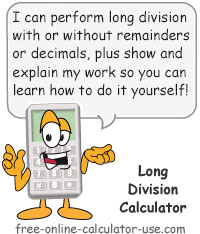IMPORTANT: Numeric entry fields must not contain dollar signs, percent signs, commas, spaces, etc. (only digits 0-9 and decimal points are allowed).
Click the Terms tab above for a more detailed description of each entry.
Step #1:
Enter the divisor in the left-hand entry box.
Step #2:
Enter the dividend in the left-hand entry box.
Step #3:
Click the "Calculate Long Division" button, which will find the quotient of the division and display an interactive, step-by-step illustration of the long division.
Important:
To show its work this calculator converts numbers to and from text while proceeding through the long division problem, which is not an exact science. Therefore be sure to check the results by multiplying the quotient by the divisor to make sure that product equals the dividend.



Follow me on any of the social media sites below and be among the first to get a sneak peek at the newest and coolest calculators that are being added or updated each month.